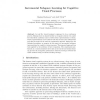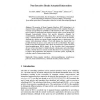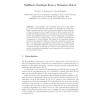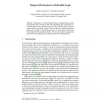107
Voted
BVAI
2007
Springer
15 years 6 months ago
2007
Springer
We present a hierarchical system for object recognition that models neural mechanisms of visual processing identified in the mammalian ventral stream. The system is composed of ne...
98
Voted
BVAI
2007
Springer
15 years 6 months ago
2007
Springer
Correlation analysis of neuronal spiking activity relies on the availability of distributions for assessing significance. At present, these distributions can only be created by su...
90
Voted
BVAI
2007
Springer
15 years 6 months ago
2007
Springer
In real life, visual learning is supposed to be a continuous process. Humans have an innate facility to recognize objects even under less-than-ideal conditions and to build robust ...
112
click to vote
BVAI
2007
Springer
15 years 6 months ago
2007
Springer
The promise of Brain-Computer Interfaces (BCI) technology is to augment human capabilities by enabling interaction with computers through a conscious and spontaneous modulation of ...
95
Voted
BVAI
2007
Springer
15 years 6 months ago
2007
Springer
Abstract. In this article we present a model of realistic drawing accounting for visuomotor coordination, namely the strategies adopted to coordinate the processes of eye and hand ...
175
Voted
BVAI
2007
Springer
15 years 6 months ago
2007
Springer
We tested the efficiency of category learning when participants are provided only with pairs of objects, known to belong either to the same class (Positive Equivalence Constraints ...
81
Voted
AUSAI
2007
Springer
15 years 6 months ago
2007
Springer
A prerequisite of any successful social robot is the ability to express its internal state and intention to humans in a natural way. Many researchers studied verbal and nonverbal f...
65
Voted
AUSAI
2007
Springer
15 years 6 months ago
2007
Springer
AUSAI
2007
Springer
15 years 6 months ago
2007
Springer
In this paper, we propose a method where humanoid robot acquires meanings of grammatical connectives using direct physical feedback from human. Our system acquired 70% connectives ...
83
Voted
AUSAI
2007
Springer
15 years 6 months ago
2007
Springer
In this paper, we extend Defeasible Logic (a computationally-oriented non-monotonic logic) in order to deal with temporalised rules. In particular, we extend the logic to cope with...




